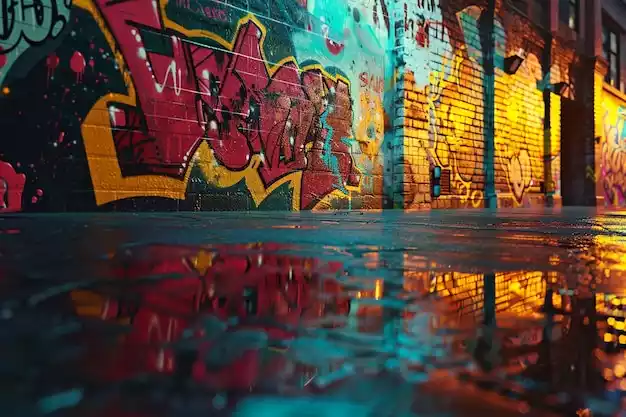Introduction
Graffiti, a form of street art, has evolved from simple tags to complex murals that tell stories and express emotions. The vibrant colours used in graffiti are a testament to the creativity and skill of the artists. Capturing these colours in photographs can be challenging but immensely rewarding. The key lies in understanding the art form, using the right equipment, and employing effective techniques.
Graffiti has a rich history, dating back to ancient civilizations. The modern graffiti movement began in the 1960s and 1970s in cities like New York and Philadelphia. Artists used spray paint to create bold, colourful pieces on walls, trains, and other public surfaces. Today, graffiti is recognized as a legitimate art form, with artists like Banksy and Shepard Fairey gaining international acclaim.
Photographing graffiti is not just about documenting the artwork; it’s about capturing the essence of the piece. The colours, textures, and context all play a role in conveying the artist’s message. To do this effectively, you need to understand the challenges involved and how to overcome them. Urban environments can be unpredictable, with varying lighting conditions and potential distractions. Additionally, graffiti is often found in hard-to-reach places, making it difficult to get the perfect shot.
In this article, we’ll explore the best equipment and techniques for capturing vibrant graffiti colours. We’ll also discuss the best locations for graffiti photography, tips for success, common mistakes to avoid, and variations in graffiti photography. By the end, you’ll have a comprehensive understanding of how to capture the true beauty of graffiti.
Equipment and Tools
Choosing the Right Camera
When it comes to graffiti photography, the camera you choose can make a significant difference. While many modern smartphones have impressive cameras, a DSLR or mirrorless camera offers more control over settings and better image quality. Look for a camera with a high dynamic range (HDR) to capture the full spectrum of colours in graffiti.
Essential Lenses for Graffiti Photography
The lens you use can greatly impact the outcome of your graffiti photos. Wide-angle lenses are ideal for capturing large murals, while macro lenses are perfect for focusing on intricate details. A versatile zoom lens can also be useful for adjusting your framing without having to move around too much.
Lighting Equipment and Techniques
Natural light is often the best option for graffiti photography, but it can be unpredictable. Carrying portable lighting equipment, such as LED panels or reflectors, can help you control the lighting conditions and highlight the vibrant colours of the graffiti. Experiment with different lighting angles to find the best way to illuminate the artwork.
Techniques for Capturing Vibrant Colours

Understanding Colour Theory
Colour theory is essential for any photographer. Understanding how colours interact and complement each other can help you capture graffiti in a way that highlights its vibrancy. Pay attention to the colour wheel and look for complementary colours in the graffiti to make your photos pop.
Optimal Camera Settings
Getting the right camera settings is crucial for capturing vibrant graffiti colours. Use a low ISO to reduce noise and maintain image quality. Adjust the white balance to match the lighting conditions and bring out the true colours of the graffiti. Experiment with different shutter speeds and apertures to find the best combination for your shot.
Post-Processing Tips
Post-processing can enhance the colours in your graffiti photos. Use software like Adobe Lightroom or Photoshop to adjust the saturation, contrast, and brightness. Be careful not to overdo it, as this can make the colours look unnatural. Aim for a balance that enhances the vibrancy without compromising the integrity of the artwork.
Best Locations for Graffiti Photography
Urban Hotspots
Cities like New York, Berlin, and London are renowned for their vibrant graffiti scenes. These urban hotspots offer a plethora of opportunities for graffiti photography. Explore different neighbourhoods and look for areas known for their street art to find the best spots.
Hidden Gems
While urban hotspots are great, don’t overlook the hidden gems. Smaller towns and less-known areas can have incredible graffiti that is often overlooked. Take the time to explore and discover these hidden treasures.
Legal Graffiti Walls
Many cities have designated legal graffiti walls where artists can create without fear of prosecution. These walls are often updated regularly, providing a constant source of new and vibrant graffiti to photograph. Research and find these locations in your area.
Tips for Successful Graffiti Photography

Timing and Lighting
The time of day can greatly affect the outcome of your graffiti photos. Early morning or late afternoon light, known as the golden hour, can add a warm and soft glow to your images. Avoid harsh midday sunlight, which can create strong shadows and wash out colours.
Composition and Framing
Composition is key in photography. Use the rule of thirds to create balanced and visually appealing shots. Pay attention to the background and try to frame the graffiti in a way that enhances its impact. Experiment with different angles and perspectives to find the most compelling composition.
Interacting with Graffiti Artists
Building a rapport with graffiti artists can provide valuable insights and opportunities. Respect their work and ask for permission before photographing them or their artwork. Engaging with the artists can also lead to unique and behind-the-scenes shots that add depth to your portfolio.
Common Mistakes to Avoid
Overexposure and Underexposure
One of the most common mistakes in graffiti photography is improper exposure. Overexposure can wash out colours, while underexposure can make them look dull. Use your camera’s histogram to ensure your exposure is balanced and adjust your settings accordingly.
Ignoring the Background
The background can make or break a photo. A cluttered or distracting background can take attention away from the graffiti. Look for clean and simple backgrounds that complement the artwork and help it stand out.
Not Respecting the Art
Graffiti is a form of expression and should be respected as such. Avoid touching or altering the artwork in any way. Always seek permission if you plan to use the photos for commercial purposes and give credit to the artists whenever possible.
Variations in Graffiti Photography
Black and White Graffiti Photography
While graffiti is known for its vibrant colours, black and white photography can add a different dimension to the artwork. It can highlight the textures and shapes, creating a more dramatic and timeless effect.
Macro Graffiti Photography
Focusing on the intricate details of graffiti can reveal hidden elements and add depth to your photos. Use a macro lens to capture close-up shots of textures, patterns, and small details that are often overlooked.
Night Graffiti Photography
Photographing graffiti at night can create a unique and moody atmosphere. Use a tripod and long exposure settings to capture the artwork in low light. Experiment with different light sources, such as streetlights or portable LEDs, to illuminate the graffiti.
FAQs
What is the best time of day to photograph graffiti?
The best time to photograph graffiti is during the golden hour, which occurs shortly after sunrise and before sunset. The soft, warm light during these times enhances the colours and adds a natural glow to the artwork. Avoid midday when the sun is directly overhead, as it can create harsh shadows and wash out the colours.
How can I enhance graffiti colours in post-processing?
Enhancing graffiti colours in post-processing involves adjusting the saturation, contrast, and brightness. Use software like Adobe Lightroom or Photoshop to fine-tune these settings. Be careful not to overdo it, as excessive adjustments can make the colours look unnatural. Aim for a balance that enhances the vibrancy without compromising the integrity of the artwork.
What are the best camera settings for graffiti photography?
The best camera settings for graffiti photography depend on the lighting conditions and the specific shot you’re aiming for. Generally, use a low ISO to reduce noise and maintain image quality. Adjust the white balance to match the lighting conditions and bring out the true colours of the graffiti. Experiment with different shutter speeds and apertures to find the best combination for your shot.
How do I find legal graffiti walls?
Finding legal graffiti walls involves a bit of research. Many cities have designated areas where artists can create without fear of prosecution. Check local art communities, online forums, and social media groups for information on legal graffiti walls in your area. Visiting these locations can provide a constant source of new and vibrant graffiti to photograph.
What should I avoid when photographing graffiti?
When photographing graffiti, avoid overexposure and underexposure, as they can wash out or dull the colours. Pay attention to the background and avoid cluttered or distracting elements that can take attention away from the graffiti. Always respect the artwork and the artists by not touching or altering the graffiti in any way. Seek permission if you plan to use the photos for commercial purposes and give credit to the artists whenever possible.
Conclusion
Capturing vibrant graffiti colours requires a combination of the right equipment, techniques, and respect for the art form. Understanding the challenges and knowing how to overcome them can help you create stunning photographs that showcase the true beauty of graffiti. Experiment with different settings, compositions, and lighting conditions to find what works best for you. Happy shooting!
References
– “The History of Graffiti” – History.com
– “Tips for Photographing Street Art” – Digital Photography School
– “Understanding Colour Theory” – Adobe
– “Best Camera Settings for Street Photography” – Photography Life
– “Finding Legal Graffiti Walls” – Street Art Cities
Graffiti in a TUNNEL – The Secret Writer 3
Ruth Aquilani is a renowned graffiti artist known for her bold, colorful, and expressive style. She began her career as a street artist in the early 2000s, quickly making a name for herself in the graffiti community with her unique and striking works of art.

[…] a juxtaposition of old and new. • Florence: Known for its Renaissance art, Florence also boasts a vibrant graffiti scene, with artists drawing inspiration from the city’s artistic […]